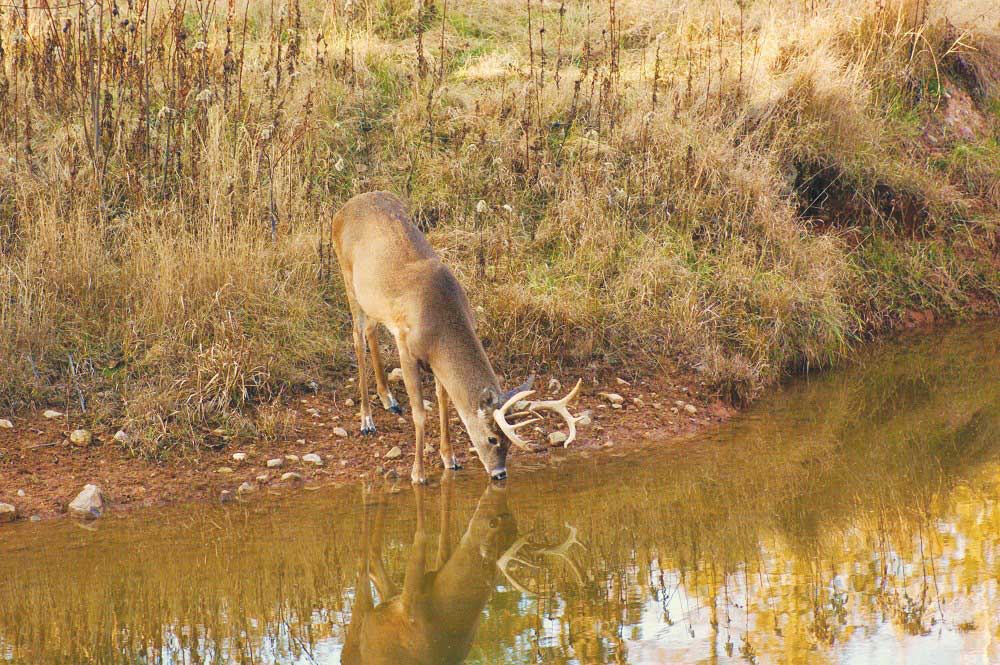Inexpensive flushing bars can forewarn fawns and young turkeys before you bush-hog.
The summer months are upon us here in Alabama and the heat and dry weather that usually come with this month are a challenge for crops and critters alike. Here are some land improvements to help attract deer to your land this hunting season.
#1 Critters Must Have Water
One often-overlooked aspect of a property being managed for wildlife is the amount of accessible water for the critters large and small to use. Accessible water is a major factor to keeping the animals you manage at home during the critical summer months.
Some places are blessed with abundant ponds and streams that run perennially, while others have very little to offer if the rain dries up and stops providing runoff for ephemeral streams and creeks. One option on properties that lack water is to create a small pond or two specifically for providing drinking water.
These small watering holes can be built in low-lying and shady areas that will hold water, and can be built by an experienced equipment operator in very short order. Another option for providing water is to use plastic or poly water tanks that can be buried or partially buried in the earth to fill with rainfall that doesn’t leach out.
I have personally used this tactic on very high and dry ridges of Alabama with great success. Tanks from 40 to 200 gallons are available at many farm stores and can be utilized on your property for a great watering source for wildlife. Remember to always leave a stick or piece of wood propped up in the tank so small critters that accidentally fall in can climb out and not pollute the water.
#2 Watch Out For The Little Guys
This is also a popular month of the season for many guys to get out there and fire up the tractor and bush-hog to cut roads, fields, or boundary lines that need trimming. Take the time to check these areas for fawns or late turkey nests just before you cut.
Many fawns every year are lost to bush-hogs, hay cutters, and other equipment. A pass through these areas beforehand with an ATV can be a great way to flush fawns or small turkeys and quail to get them out of harm’s way.
Flushing bars can also be built very inexpensively for the front of your tractor to warn wildlife before they are injured. These flushing bars are simply made from a metal or heavy schedule pipe attached to the bucket or front weight bar on the tractor extending 8 to 10 ft with short chains attached that rattle and alert unaware animals to move out of the way.
A study showed that mortality on juvenile rabbits was decreased by 80% when flushing bars were used.
#3 Vitamins Don’t Just Happen
If you put out minerals for your deer herd earlier in the spring, chances are it’s time to refresh those sites and make sure there is plenty available. Bucks are right in the middle of the antler-growing process and does are heavy with the burden of carrying a fawn or two.
“If you put out minerals for your deer herd earlier in the spring, chances are it’s time to refresh those sites and make sure there is plenty available.”
This time of year can be taxing on a whitetail’s body. They need plenty of high-protein forage and available minerals for optimum growth and health. Ideally, you should provide one mineral site for every 80 to 100 acres of ground.
I like to place some of these somewhat close to water sources as it seems to increase utilization. Also, placing a mineral rock or powder on rotting stumps off in thickets or pine plantations can be very effective. Oftentimes, older age class bucks will use these licks that are less visited by the younger deer and in a secluded area.
This is a great way to get pictures on your trail camera of those old reclusive bucks. Old hardwood stumps make ideal locations for mineral licks, as the rain hits the site over time, the minerals leach into the wood and old root system and soil surrounding the stump.
Whitetails love to paw and consume the mineral-rich soil and wood mulch.

Photo by Austin Delano.
#4 A Time For Lime
With such a wet spring in Alabama this year, this is a good time to get your soil samples taken on areas you plan to plant this fall and get the appropriate lime spread.
Ag lime, also called powdered lime, can take a few months to start working on neutralizing the acidity of your soil. Depending on the how fine a mesh the quarry runs the lime through, the coarsest lime can sometimes take up to a year to fully break down.
Very fine and powdery lime that has been run through a smaller screen will provide a little faster result. Liming is probably the most-overlooked aspect of growing successful food plots. Soils that are acidic keep nutrients bound up and unavailable to plants, regardless of how much fertilizer is applied.
For example, a soil with a pH value of 5.0 to 5.5 will keep over 50% of the applied fertilizer unavailable. Nutrient uptake by plants, increased growth and plot health, as well as increased utilization by deer will all be noticed when plots are appropriately limed and pH values brought into that 6.5 to 7.0 range.
If you have had limited success on growing crops in food plots or wildlife openings, get your pH right before you buy another bag of fertilizer.

